Ellsworth Rogue 40 – A Return to Greatness for a Storied Brand
Ellsworth has been fabricating mountain bikes for over 25 years. With subtle refinement over the years, the Ellsworth Active Energy Efficient Suspension design remains one of the most proven designs in terms of both climbing acumen and supple absorption of bumpy technical stuff. The carbon frame equipped Ellsworth Rogue 40 and Rogue 60 were introduced in 2016 with the intent of bringing current carbon technology to enhance the fundamental proven Ellsworth suspension design. The new carbon frame designs not only look sharp, but shows that a good design properly refined can just get better with time. We’ll focus on the 140mm travel Trail based Ellsworth Rogue 40 in this review, but many of these characteristics carry over to the longer travel, 160mm travel, Enduro based, Rogue 60 as well.
A Little Ellsworth History
Ellsworth Bicycles has had its ups and downs as a company through the years. After ambitious plans of U.S. frame manufacturing powered solely by renewable energy were tempered by lack of product delivery, Tony Ellsworth sold Ellsworth Bicycles to BST Nano Carbon in 2014. BST had aggressive goals to build bikes, wheels and other bicycle items, but unfortunately lacked sufficient finances to support these plans. In January 2016, Ellsworth was sold to mountain bike enthusiast Jonathan Freeman. Jonathan is hopefully just what Ellsworth needs – the ability to execute and deliver Tony Ellsworth’s very good frame and suspension designs to the market.
On this note, Tony is still with the company. Having Jonathan there to manage the business side of things allows him to focus on what he does as well as anyone in the industry – designing and building mountain bikes of the highest quality. In addition to Tony staying on-board on the design side, much of BST Nano’s very experienced engineering staff stayed at Ellsworth. This gives Ellsworth a lot of capability and potential. We are excited to see Ellsworth delivering bikes more consistently than ever as of late and the bikes that we are receiving look great. Maybe you can teach an old dog new tricks…
Ellsworth Rogue 40 Frame Details
The new Ellsworth line is punctuated by the Rogue 40 and Rogue 60. The Rogue 60 is a thoroughly modern all-mountain Enduro bike, with carbon fiber frame construction (excepting the alloy chainstays and suspension bits). The Ellsworth Rogue 40 is a very similar design, but tuned more towards Trail use with 20mm less travel. The bike is designed around the Fox 34 fork and the 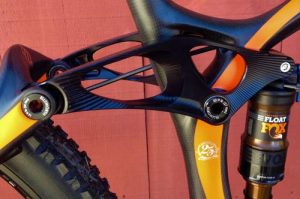 Fox Float EVOL DPS Factory rear shock, offering 140mm of travel front and rear. The fork and rear triangle on both Rogues are “Boost” design, meaning 110mm wide at the front and 148mm wide at the rear. The main benefit to “Boost” width bikes is that it increases the width of the hub flanges by about 6mm and thus allows for a stronger spoke angle to the rim. The bottom bracket of the Rogue is 73mm wide and English threaded. Mechanically, this is a nice touch – no PressFit creaking here. The alloy rear derailleur hanger is replaceable and the seat tube is oversized at 30.9mm.
Fox Float EVOL DPS Factory rear shock, offering 140mm of travel front and rear. The fork and rear triangle on both Rogues are “Boost” design, meaning 110mm wide at the front and 148mm wide at the rear. The main benefit to “Boost” width bikes is that it increases the width of the hub flanges by about 6mm and thus allows for a stronger spoke angle to the rim. The bottom bracket of the Rogue is 73mm wide and English threaded. Mechanically, this is a nice touch – no PressFit creaking here. The alloy rear derailleur hanger is replaceable and the seat tube is oversized at 30.9mm.
Ellsworth Rogue 40 Frame Geometry
Relaxed head tube angles are the name of the game on modern Enduro and Trail bikes. The Ellsworth Rogue 40’s head tube angle comes in at 67 degrees, just a degree steeper than what is found on the Rogue 60. On the other end, the seat tube angle of the Ellsworth Rogue 40 comes in at a steep, climbing friendly, 75 degrees (a degree steeper than the Rogue 60). Bottom bracket height on the Rogue 40 is 13.5 inches (34.2cm). The headtube is tapered, a feature pretty much required for any modern mountain bike design, providing for a laterally stiffer and more responsive front end. Combine all of these elements with the short 420mm chainstays and the result is a bike that is not only stable at speed, but quite quick in the tight stuff. This is ideal for many of the technical trails we see in Northern New England.
Ellsworth Rogue 40 Suspension Design
The Ellsworth Rogue 40 frame has a number of unique design elements worthy of mention:
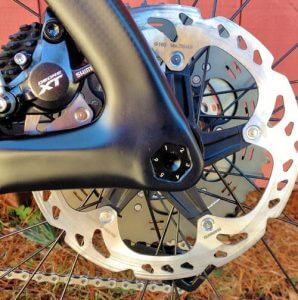
-
Ellsworth “Rocker Locker”
The “Rocker Locker” replaces traditional shock mounting hardware with a custom machined 7075 pivot pin. This pin is ovalized at each end, rather than being simply round. These oval ends insert into the shock rocker arms. This locks the right and left arms together so that one cannot move without the other. This enhances torsional stiffness.
-
Ellsworth “Hex Taper” Axle
The “Hex Taper” axle is Ellsworth’s name for the rear thru axle. The frame has a hexagonal indentation on the left side and the thru axle has a matching hexagonal male end that inserts into the frame indentation. The thru axle is thus locked firmly into the left side of bike. This variation of the usual thru axle design helps stiffen the rear axle and triangle of the bike.
-
Ellsworth “Instant Center Tracking”

Ellsworth Carbon Torsion Arch The four-bar rear suspension linkage, dubbed “Instant Center Tracking”, is designed to align the virtual pivot point of the rear suspension with the chain force line. Tony Ellsworth has been refining this design for over 17 years. The linkage design virtually eliminates any bobbing when you pedal, while also eliminating suspension kickback when the suspension is compressed. The goals of this design are to allow the bike to be ridden over pretty much any terrain with the rear shock in the open and most active position. The suspension linkage is also a minor work or art. It is beautifully machined.
-
Ellsworth “Carbon Torsion Arch”
The two seatstays are tied together by the “Carbon Torsion Arch”. This carbon fiber bridge is molded as part of the monocoque that makes up both seatstays, tying them together. The effect is a stiffer rear triangle.
The added stiffness from the Carbon Torsion Arch, Hex Taper, and Rocker Locker, make the rear of the Ellsworth Rogue 40 noticeably more efficient and responsive to steering and pedaling input. Ellsworth’s have always been good in this regard. The latest Rogue 40 design makes them great.
Ellsworth Rogue 40 Cable Routing
Routing for all brake hoses, derailleur cables (including Di2), and dropper seatpost housing, is internal on the Rogue 40. It looks nice and clean and is well protected. There is also a compartment in the down tube to house a Shimano Di2 battery. Moving the Di2 battery out of the seatpost allows the use of a dropper seatpost, which you will want on this bike…
Ellsworth Rogue 40 Fork and Shock
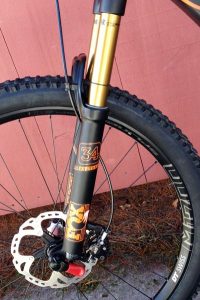 The Fox Factory 34 Series fork has a 15mm thru axle, with Boost (110mm) spacing. There are three lever settings: Open, Medium, and Firm. This allows you to tailor the fork’s response to trail conditions. In addition, when in the Open position, the fork has an additional 22 clicks of low speed compression adjustment for fine tuning. There is no remote control for these various adjustment. This is not an issue on an Ellsworth – the idea is “Active” suspension.
The Fox Factory 34 Series fork has a 15mm thru axle, with Boost (110mm) spacing. There are three lever settings: Open, Medium, and Firm. This allows you to tailor the fork’s response to trail conditions. In addition, when in the Open position, the fork has an additional 22 clicks of low speed compression adjustment for fine tuning. There is no remote control for these various adjustment. This is not an issue on an Ellsworth – the idea is “Active” suspension.
Ellsworth is a suspension design company. They handily demonstrate this by having the rear suspension be managed by a Fox DPS Factory shock with Kashima coating. There are no corners being cut here. This shock has three lever operated modes: Open, Medium and Firm. Like the front, there is no remote and Ellsworth would ask why you would ever want to limit their suspension design’s traction anyhow. In the Open mode, there are three low speed compression settings. The EVOL (“Extra Volume”) air sleeve reduces the force to initiate travel, for better responsiveness, particularly over small bumps. The feel of the air spring can be adjusted with air volume spacers. Of course rebound is adjustable on both the fork and the shock.
Ellsworth Rogue 40 Components
At Fit Werx, we build bikes for riders. We can build out an Ellsworth Rogue 40 exactly as you need/want from a frame in the shop. This being said, Ellsworth has done a good job of building some straight-forward and very functional factory build kits that work well for many riders.
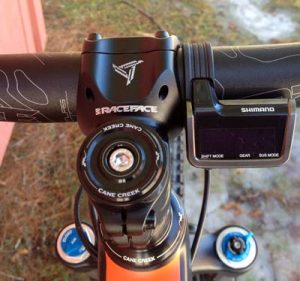
The Rogue 40 is available from the factory with a choice of Shimano and SRAM drivetrains: Shimano SLX 1X, Shimano XT 1X, Shimano XT Di2, Shimano XTR 1X, and SRAM X01. The bike pictured is equipped with Shimano XT Di2. Last year electronic mountain bike shifting was only available with Shimano’s top-of-the-line XTR series. But, Shimano brought Di2 down to XT this year and at a substantial price savings. All we can say about
Di2 on mountain bikes is, “try it before you criticize it”. Like with road bikes, it is cool technology that provides great shifting performance.
As gearing ranges have expanded, 1x single chainrings have become more and more popular on mountain bikes. The Rogue 40 comes equipped with an 11-46 cassette, coupled with a 32 tooth front chainring. Shimano makes replacement chainrings for this crank with either 30 or 34 teeth, so you can tailor the gearing to your personal liking. The combination of a 32 tooth front chainring and a 46 tooth rear cassette cog does not give quite as low a gear as old-school triple cranksets, coupled with an 11-36 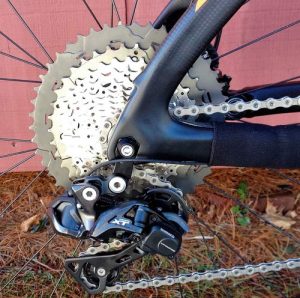 cassette. It is very close though. Having an ever-so-slightly higher low gear – while getting rid of the troublesome front derailleur, the heavy double or triple crank, and the risk of throwing a chain when shifting – is a very worthwhile tradeoff in my book. Also, if you want lower gearing on a 1x, have us build your Ellsworth from a frame with SRAM XO1 Eagle 12 speed and its massive 10-50 cassette.
cassette. It is very close though. Having an ever-so-slightly higher low gear – while getting rid of the troublesome front derailleur, the heavy double or triple crank, and the risk of throwing a chain when shifting – is a very worthwhile tradeoff in my book. Also, if you want lower gearing on a 1x, have us build your Ellsworth from a frame with SRAM XO1 Eagle 12 speed and its massive 10-50 cassette.
The braking system on the XT kit on the Rogue is Shimano XT 8000. The front brake rotor is 180mm while the rear is 160mm. The brake rotors are of Shimano’s Ice Tech
design, while the brake pads have cooling vanes, for improved heat management. Better brake performance results from these lower temperatures. The XT8000 brakes have good feel and modulation, in addition to excellent stopping power.
DT Swiss M1700 Spline 2 Wheels
The standard wheels on most of the factory Rogue 40 builds are the 27.5″ DT Swiss M1700 Spline 2. The Spline 2 is an alloy mountain bike wheelset, featuring DT Swiss hubs and 22.5mm wide alloy rims, laced with DT Swiss Competition spokes. At 1705 grams, the wheels are a very reasonable weight for a stock mountain bike wheelset. The wheels are shod with Maxxis High Roller II tires, 27.5″ X 2.3″. Both the tires and the rims are tubeless compatible. Tubeless saves the weight of heavy rubber tubes while also providing flat protection. The wheels come with the necessary parts to convert them for tubeless use. Ellsworth also offers a factory upgrade to a Reynolds Enduro 275 wheel for those looking for a step-up in performance.
Race Face Turbine Dropper Seatpost
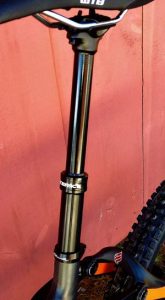 The Ellsworth Rogue 40 is equipped with the Race Face Turbine Dropper seatpost. This is a cable actuated design, with the cable and housing all routed inside the bike’s frame. The Race Face Turbine uses a spring-loaded, fluid-filled brake inside the seat tube. This brake expands, wedging it against the inside walls of the post, which holds the seatpost at the level selected by the rider. If for some reason air leaks out of the seatpost while you are riding, the expanding brake will remain in place. The seatpost will not collapse to its lowest point. This is a nice advantage to the design if you have a problem deep in the woods.
The Ellsworth Rogue 40 is equipped with the Race Face Turbine Dropper seatpost. This is a cable actuated design, with the cable and housing all routed inside the bike’s frame. The Race Face Turbine uses a spring-loaded, fluid-filled brake inside the seat tube. This brake expands, wedging it against the inside walls of the post, which holds the seatpost at the level selected by the rider. If for some reason air leaks out of the seatpost while you are riding, the expanding brake will remain in place. The seatpost will not collapse to its lowest point. This is a nice advantage to the design if you have a problem deep in the woods.
When it comes to rebounding to full height, an air spring provides the force that pushes the seatpost upwards when the control lever is depressed. Air pressure (between 20-40psi) is added via a Schrader valve hidden under a rubber cap at the top of the post, under the seat clamp. This is an awkward location. Changing the air pressure requires removal of the saddle and the saddle clamp. However, other posts, such as the Rock Shox Reverb, have their air valve at the same location, so it is what it is. Our seatpost came maxed out at 40 psi from the factory. At that pressure, when compression was released, the seatpost sprang up with such force that… Well, you get the picture. We lowered the pressure to 25 psi and it was much more controlled.
Operation is standard procedure for dropper posts. When sitting on the saddle, hit the control level, and the post will drop down. To raise the post, press the lever, and raise your weight off the saddle. You can stop the post anywhere in its travel by simply releasing the control lever.
Ellsworth Rogue 40 Frame Design and Sizing
The Ellsworth Rogue is a very elegant design. The frame visually flows together without extraneous curves or frills. The carbon fiber is laid up and finished to a very high degree. While beauty may be in the eye of the beholder, I find this bike very visually appealing.
Aesthetics aren’t worth a great deal if the performance is not there though. It is winter in Vermont and thus we aren’t logging much saddle time on anything without 4”+ wide tires. This being said, Ellsworth bikes have always ridden well and it is hard to imagine that the Rogue won’t be the best Ellsworth yet. Other reviewers who have ridden the Ellsworth Rogue are very favorably impressed, ranking the Rogue with other “best in class” options. Most have commented on the stiffness of the rear of the bike, and how that added stiffness improves performance and handling. Thank you Carbon Torsion Arch, Hex Taper, and Rocker Locker. The combination of a steep seat tube angle, short chainstays and slack (but not overly so) head tube angle is a recipe for a pretty tasty meal for most. Anytime you can enhance climbing and descending on a trail bike, you are helping the rider.
The Rogue 40 comes in 3 sizes, Medium, Large and Extra Large. Ellsworth recommends the Medium size for riders at least 5’7″ tall, with an inseam of at least 29″. So, unfortunately these are not bikes for small riders. The XL has a reach of 49.9cm – making it quite long and a good fit for many bigger riders who may not normally be thinking about a 27.5” bike.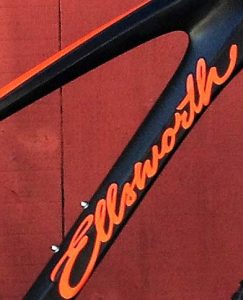
Ellsworth Rogue Colors and Pricing
The Rogue is available in three color schemes: Back in Black (all raw 3K carbon fiber), Foxy Orange (black carbon fiber and orange), and Captain America (red, blue and black). 2017 prices for complete bikes range from $5,195 for the SLX 1X drivetrain to $6999 for the XTR 1X equipped bike. Our floor bike, equipped with XT and Di2 electronic shifting, comes in at $6895. Frames are $3300. Ellsworth also offers the Rogue 60. The Rogue 60 has the same component package choices, and uses the same basic frame as the 40, but offers 160mm shock travel front and rear. The Rogue 60 adds a few hundred dollars in price for the longer travel Enduro chassis and suspension.
Ellsworth Performance Satisfaction Guarantee
Everyone likes a slam dunk. Ellsworth is so confident in the Rogue 40 that they back it up with the following:
“It is our pledge to our customers that a new stock 2017 Ellsworth bike will perform better and provide you with a mountain bike ride like no other in the market. We feel so confident in that pledge that you will have more fun, get a new PR on Strava, and enjoy the sport of mountain biking that much more, we will take your stock 2017 Ellsworth back after 30 days. There is no risk to your ultimate rider experience on a bike with more traction, better control and the best pedal efficiency in the market.”
A $250 restocking fee applies and the bike must be in good shape. Ellsworth puts their money where their mouth is when it comes to knowing what their bikes can do when properly set-up.
Ellsworth Rogue 40 Summary
The Ellsworth Rogue 40 and Rogue 60 give long-time Ellsworth fans new bikes that should make their “must have” list in short order. They should also open the door to a whole new group of riders who may not have seriously considered the brand before. These bikes are a great leap forward for Ellsworth, returning the brand to a position to contend with other “best in category” bikes in the very competitive Enduro and Trail categories.
Contact us to discuss how well an Ellsworth fits and works for you. We also often have a demo Rogue 40 in our VT location if you want to try one.

